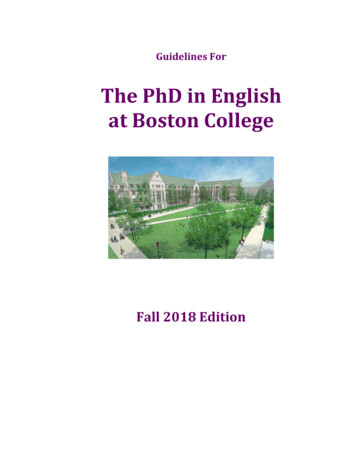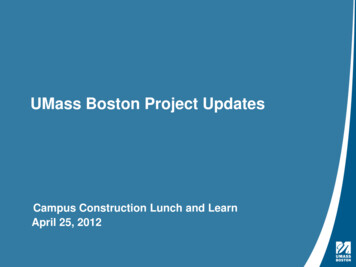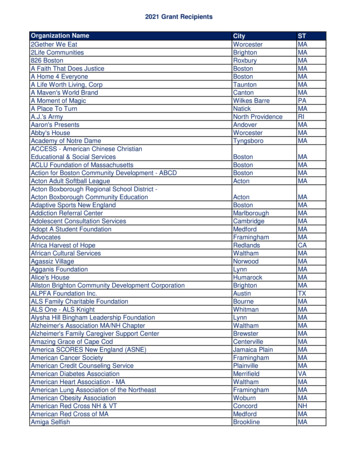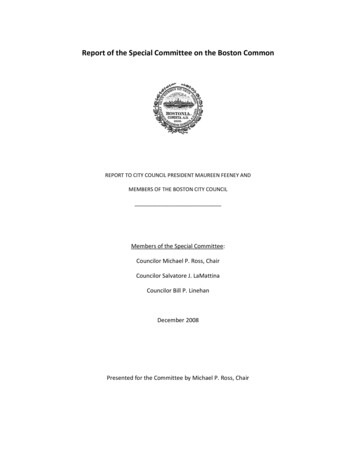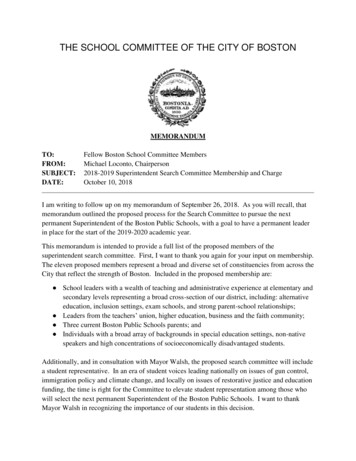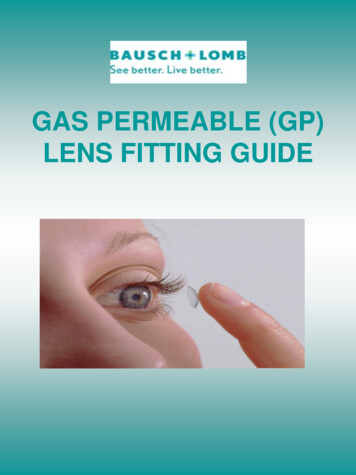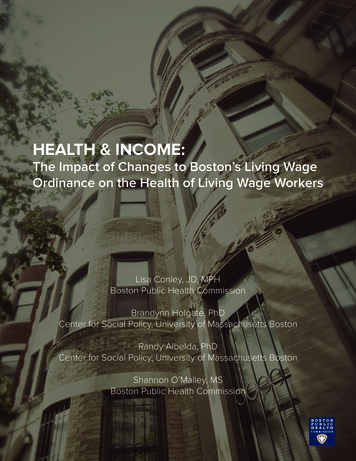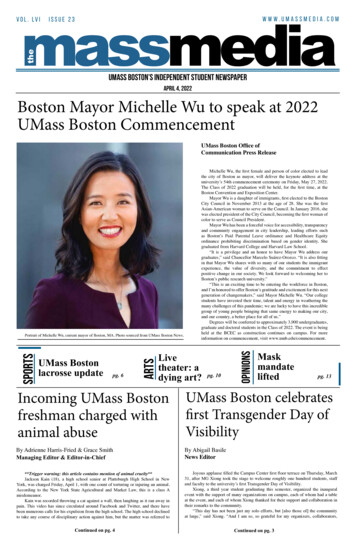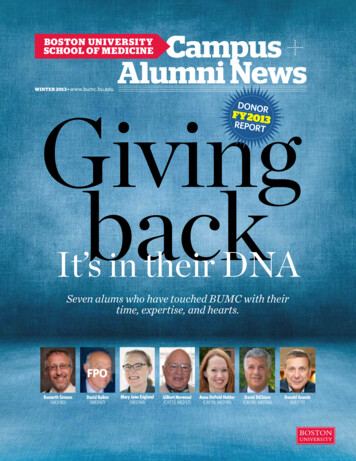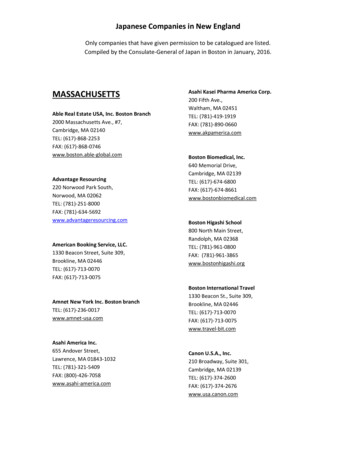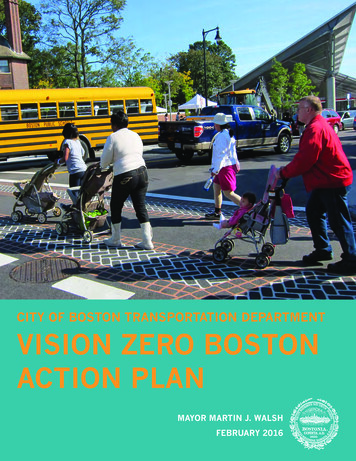
Transcription
CITY OF BOSTON TRANSPORTATION DEPARTMENTVISION ZERO BOSTONACTION PLANMAYOR MARTIN J. WALSHFEBRUARY 2016
CITY OF BOSTON TEAMMAYOR MARTIN J. WALSHChris Osgood, Chief of StreetsGina Fiandaca, Commissioner, Boston Transportation DepartmentMichael Dennehy, Commissioner (Interim), Boston Public Works DepartmentWilliam B. Evans, Commissioner, Boston Police DepartmentJames Hooley, Chief, Boston Emergency Medical ServicesHuy Nguyen, Executive Director, Boston Public Health CommissionJascha Franklin-Hodge, Chief Information OfficerKristen McCosh, Commissioner, Boston Commission for Persons with DisabilitiesMartin J. Walsh, MayorCommission on Affairs of the Elderly[ 2 ] Vision Zero Boston: Action Plan
TABLE OF CONTENTS5. Letter from the Mayor6. Core Principles of Vision Zero8. The Evolution of Vision Zero Boston10. Vision Zero Boston: Why Now?12. Focusing on the Issues15. Detailed Action Plans16. Action Plan to Reduce Speeds andBuild Safer Streets18. Action Plan to Reduce Distractedand Impaired Driving20. Action Plan to Engage Bostonians inVision Zero22. Action Plan to Hold OurselvesAccountable23. What You Can Do24. ConclusionVision Zero Boston: Action Plan [ 3 ]
SPEED KILLS ALL TYPESOF ROAD USERS: DRIVERS,PEDESTRIANS, AND CYCLISTS.A 5% CUT IN AVERAGE SPEEDCAN REDUCE THE NUMBER OFFATAL CRASHES BY AS MUCHAS 30%.(WHO, 2007)[ 4 ] Vision Zero Boston: Action Plan
I AM PROUD TOBE THE MAYOR OFAMERICA’S WALKINGCITY.Dear Bostonians,I am proud to be the Mayor of America’s Walking City.I know that with that title comes the responsibility toensure that the hundreds of thousands of Bostoniansand visitors who use our streets every day have asafe and enjoyable experience. Unfortunately, an average of two pedestriansare hit by cars every day – people like you and me who are simply trying to getacross the street. Almost as many people riding bikes are treated by our EMSand every year thousands of drivers are injured, put in danger, or delayed bycollisions with other vehicles.While only a handful of these crashes are fatal, every tragedy leaves a trail ofgrieving family and friends, and the despair of unfulfilled potential. As Mayor, Isee the real people behind these statistics; I share the grief, pain, and sense ofloss that every crash report represents.I grew up in Dorchester. We could walk to the store, to church, to a friend’shouse, or to a park. We could ride our bikes to school or to Boston Harbor. Wecould get on a subway train or a bus and go to work almost anywhere in GreaterBoston. That freedom of movement is what made it a strong community – tightlyknit and human scaled, but also fully connected to the wider world of jobs,amenities, and culture.Children growing up today deserve that same level of freedom and mobility. Ourseniors should be able to safely get around the communities they helped buildand have access to the world around them. Driving, walking, or riding a bike onBoston’s streets should not be a test of courage.We know how to build safer streets. We know how to protect our mostvulnerable road users, who are suffering disproportionately because of speedingtraffic and distracted drivers.With this Action Plan, I am saying it’s time to act. It’s time to commit toeliminating fatal and serious traffic crashes from our daily experience.IT’S TIME FOR VISION ZERO.Sincerely,Martin J. WalshVision Zero Boston: Action Plan [ 5 ]
VISION ZERO BOSTONCORE PRINCIPLES OF VISION ZEROThe Vision Zero concept was created in Sweden in 1997 and is widely creditedwith a significant reduction in fatal and serious crashes on Sweden’s roadssince that time.Cities across the United States are adopting bold Vision Zero initiatives thatshare common principles:1. Traffic deaths are preventable and unacceptable.2. Human life takes priority over mobility and other objectives of the roadsystem. The street system should be safe for all users, for all modes oftransportation, in all communities, and for people of all ages and abilities.3. Human error is inevitable and unpredictable; the transportation systemshould be designed to anticipate error so the consequence is notsevere injury or death. Advancements in vehicle design and technologyare necessary to avoid the safety impacts of human errors and poorbehaviors.4. People are inherently vulnerable and speed is a fundamental predictor ofcrash survival. The transportation system should be designed for speedsthat protect human life.5. Safe human behaviors, education, and enforcement are essentialcontributors to a safe system.6. Policies at all levels of government need to align with making safety thehighest priority for roadways.30MPH20MPH18% likelihoodof fatalityor severeinjury50% likelihoodof fatalityor severeinjury40MPH77% likelihoodof fatalityor severeinjurySource: Impact Speed and a Pedestrian’s Risk ofSevere Injury or Death, Brian Tefft, AAA Foundationfor Traffic Safety, 2011[ 6 ] Vision Zero Boston: Action Plan
WHAT DOES THIS MEAN FOR BOSTON?Vision Zero Boston is our commitment to focus the city’s resources on provenstrategies to eliminate fatal and serious traffic crashes in the city by 2030. Weare inspired by the belief that even one fatality is too many.While Boston has a relatively good record on traffic safety compared to manyother cities, Mayor Walsh is not content to accept 20 fatalities and 200 serious injuries on city streets every year. Death and serious injury are not partof the cost of doing business in a busy city.Vision Zero Boston looks behind the statistics at the human and economic costof traffic crashes; the barriers created by busy, high-speed roads in the heartof our city; and the impact of speeding on neighborhood streets that can limitaccess, mobility, and opportunity in communities that need it the most.Vision Zero Boston makes traffic safety personal. Bostonians are going to meetthe victims of serious traffic crashes and the family and friends of people killedon our streets. These are not just statistics, and traffic safety isn’t someoneelse’s problem.Vision Zero Boston prioritizes safety and takes a people-first approach totransportation and community building. Most trips in the City of Boston are madeby people on foot, bike, or transit. Everyone, including drivers, benefits from atransportation system that’s made safer for the most vulnerable road users.Vision Zero Boston promises action in four criticalareas:REDUCING SPEEDSAND BUILDINGSAFER STREETSTACKLINGDISTRACTED ANDIMPAIRED DRIVINGENGAGINGBOSTONIANS WITHVISION ZEROHOLDINGOURSELVESACCOUNTABLE FORRESULTSVision Zero Boston: Action Plan [ 7 ]
THE EVOLUTION OFVISION ZERO BOSTONBoston is a city of many “firsts” in transportation. Pierre Lallement, a Bostonresident from 1865-91, received a patent in 1866 for the invention of pedalsand crank arms that revolutionized the velocipede and enabled the modern-daybicycle to emerge. In 1897, the Tremont Street Subway became the nation’sfirst subway and in 1904, the City built the nation’s first underwater mass transittunnel.The City was also a pioneer in recognizing the importance of open spaceand livability. Visionaries such as Frederick Law Olmsted and Charles Eliotdesigned the Emerald Necklace and the Metropolitan Park System, includingthe parkways, in the 1880s and 1890s, and ensured critical access to naturalenvironments throughout the city.In 1973, Governor Francis W. Sargent stopped a plan to build the SouthwestExpressway through the heart of the city and set the stage for using highwayfunds to build the Orange Line and the Southwest Corridor Park. In the 2000s, apedestrian-friendly network of streets were built along greenways in downtownand East Boston as part of the Central Artery project.In more recent times, the City has embraced the benefits of a more walkable,bikeable, and transit-friendly community. This was made possible by of a seriesof notable active transportation policies, plans, and programs, including theadoption of a Complete Streets approach to street design, the constructionof numerous public spaces that are safer for pedestrians and bicyclists, thecreation of the Boston Bikes program in 2007, and the launch of the Hubwaybike share system in 2011.In 2014, the City launched a bold new initiative to envision the future oftransportation. Go Boston 2030 features new forms and unprecedented levelsof public engagement. The draft Go Boston Vision Framework, released inSeptember 2015, focuses on broad goals and targets. An Action Plan to bereleased in 2016 will identify specific policies and projects to be implementedover the next 5, 10, and 15 years.Go Boston 2030 heralded the arrival of Vision Zero Boston, one of the earlyaction items in the Vision Framework.[ 8 ] Vision Zero Boston: Action Plan
2015: A YEAR OF PROGRESSSPRING2015In March 2015, Mayor Walsh announces that the City is committed to eliminatingfatal and serious traffic crashes by 2030.Within a month of this announcement, BTD Commissioner Gina Fiandaca instructsCity staff to replace the word “accident” with “crash”, an important practical andsymbolic step in changing the way the City thinks about traffic safety.In May 2015, a Vision Zero Boston Task Force is established. Led by BTD,the group immediately identifies priority issues and locations on which tofocus the city’s resources and attention. Massachusetts Ave and CodmanSquare emerge as high-crash areas – a fatal crash in one of these areaslater in the summer confirms the need for this focused action.SUMMER2015FALL2015Throughout the summer and fall of 2015, the Vision Zero Boston Task Forcecompiles and analyzes crash reports and data from the Boston Police Departmentand Boston Emergency Medical Services and conducts audits of high-crashlocations to better understand the scope of the challenge ahead – a challengethat requires everything from legislative and policy changes, to rapid responses tocrashes on the ground, to the implementation of new and improved street designsand traffic safety enforcement programs.VISION ZERO TASK FORCEThanks to the leadership and commitment of the Vision Zero Boston Task Force,the City has a clearer picture of why action is needed now to make our citystreets safer for everyone.Boston Police DepartmentBoston Public HealthCommissionDepartment of Innovation& TechnologyWalkBostonBoston Cyclists UnionBoston Public SchoolsBoston TransportationDepartmentBoston Commission forPersons with DisabilitiesBoston Public WorksDepartmentBoston Commission for theAffairs of the ElderlyBoston EmergencyMedical ServicesMayor’s Office of NewUrban MechanicsVision Zero Boston: Action Plan [ 9 ]
VISION ZERO BOSTON: WHY NOW?PUTTING THIS INTO PERSPECTIVEFROM 2010-201479 PEOPLEFatality data from the Boston Police Departmentindicates that, despite some anomalies in thedata, pedestrian fatalities are on an upwardtrend. By contrast, bicyclist fatalities are fairlystable and driver fatalities have been decliningslightly over time. The trend for pedestriansunderscores the importance of addressingsafety through Vision Zero efforts.WERE KILLED IN A MOTOR VEHICLE,BICYCLE, OR PEDESTRIAN CRASH ONBOSTON ROADS. Source: Boston Police DepartmentYEARLY FATALITIES, BY MODE14pedestrianmotor vehiclebike121086number offatalities4202010PERCENTAGE OF TOTAL FATALITIES,BY MODEPERCENTAGE OFTOTAL INJURIES,BY 2201320142014-2015(N 15)(N 10)(N 21)(N 16)(N 17)(N 444)motor vehiclebikepedestrian[ 10 ] Vision Zero Boston: Action Plan2011Source: Fatality data – Boston Police Department,Injury data – Boston EMS.Fatality data does not include crashes on roadwaysthat are not owned by the City of Boston.201220132014It is important to keep in mindthat these statistics do notaccount for exposure – that is,how many people walk, bike, anddrive and how many miles theytravel by those modes in Boston.While fewer bicyclists are killedthan pedestrians or drivers, thereare also many fewer peopleriding a bicycle in Boston, sotheir risk of being killed is likelymuch higher than raw fatalitynumbers suggest. Conversely,given the many thousands ofdrivers driving many thousandsof miles each year, the handful ofdriver fatalities likely results in acomparatively low risk of a driverfatality on Boston’s roadways.
IN 2014,1,279 PEOPLEREQUIRED EMS DUE TO APEDESTRIAN OR BICYCLISTCRASH ON BOSTON ROADS2-3Source: Boston EMSLEVEL OF CAREperper day,day,onon averageaverageBoston Emergency Medical Services transport disposition is classified in one of four maincategories: Basic Life Support (BLS), Advanced Life Support (ALS), on-site fatality, andpatient refusals. BLS ambulance transport is primarily for patients with non-life-threateninginjuries, whereas ALS ambulance transport tends to be for more serious injuries requiringadvanced care. In 2014, most pedestrians and bicyclists injured in a crash received BLStransport to the hospital. ALS transport occurred for 13% of pedestrians and 5% of bicyclists involved incrashes. On-site fatalities documented by Boston EMS do not include patients in critical condition whodo not survive after transport to the hospital. Thankfully, on-site fatalities were rare, at less than 1% forboth modes. Additionally, a portion of pedestrians and bicyclists refused to accept medical transport afterbeing involved in a crash.724CRASH TYPEPEDESTRIANS INJURED IN CRASHESunknnon-1%13%73%14%On-site FatalityAdvanced Life SupportBasic Life SupportRefusalownroadway5%5%area6%backed intoteeglon 5 crashescrossing street52%motor vehicle%11straunknadownro55573%su5%cerfaBICYCLISTS INJURED IN CRASHES%12On-site FatalityAdvanced Life SupportBasic Life SupportRefusal16%other2%keveh2%icledoo 1r0% 1%5%68%27%ian 5 crashesSource: Boston EMSpbistreedVision Zero Boston: Action Plan [ 11 ]
FOCUSING ON THE ISSUESWHILE FATAL CRASHESHAVE OCCURREDTHROUGHOUT THECITY, THEY ARE MORECONCENTRATED INCERTAIN AREAS.Boston Police DepartmentReported Traffic Fatalities2010-2014pedestrian fatalitybicyclist fatalitymotorist fatalityFatality data does not include crashes onroadways that are not owned by the City ofBoston.ARTERIAL ROADWAYS ARE DISPROPORTIONATELYDANGEROUS FOR ALL MODES.LOCALROADARTERALRIOAD8x9x8xmore pedestrians died on arterialroads than on local roadsmore bicyclists died on arterialroads than on local roadsmore drivers died on arterialroads than on local roadsSource: Fatality data 2010-2014 – Boston Police Department,GIS data – City of BostonNEIGHBORHOOD SLOW STREETS50% MORE PEDESTRIANSWERE KILLED ON BOSTON’SROADWAYS THAN MOTORISTSSource: Fatality data 2010-2014 –Boston Police DepartmentNearly 2 times asmany pedestrians[ 12 ] Vision Zero Boston: ActionPlanwerekilled onThe Boston Transportation Department, in partnership withthe Public Works Department, is developing a programthat will enable residents to apply for traffic calming onresidential streets in their neighborhoods. The program willimprove safety by slowing drivers with visual and physicalcues, and create residential streets that are safe andinviting for walking, bicycling, and playing.
INITIAL TARGET AREASVISION ZERO PRIORITY CORRIDORSMASSACHUSETTS AVECODMAN SQUARENEIGHBORHOOD SLOW STREET PILOT ZONESSTONYBROOKTALBOT-NORFOLK TRIANGLEVision Zero Boston: Action Plan [ 13 ]
[ 14 ] Vision Zero Boston: Action Plan
DETAILED ACTION PLANSVision Zero Boston is an Early Action Project of Go Boston 2030, the ongoingcity-wide transportation plan. After an extensive community engagementprocess, safety emerged as a major theme in the questions and commentsdonated by Bostonians. As a result, “Eliminate traffic fatalities in Boston” is oneof the primary targets in Go Boston 2030’s Vision Framework.Within the Boston Transportation Department (BTD), the Green Links Initiativeand Boston Bike Network Plan both focus on ways to protect people who walk,bike, and use other active transportation choices to get around the City. Ongoingcapital projects, including Connect Historic Boston and the Commonwealth Averedesign, are introducing design features to make streets significantly safer forvulnerable users.Other agencies are also working to make streets safer through new programs,partnerships, and improved information sharing. The Boston Public HealthCommission (BPHC) supports Safe Routes to School and a range of communityhealth partnerships. The Boston Police Department (BPD) and BostonEmergency Medical Services (EMS) are collecting and analyzing data in newways to track crashes on our roadways.Guided by representatives from across City departments, the Vision ZeroBoston Task Force has developed a holistic and detailed Action Plan thatconnects and integrates these ongoing City and community initiatives toestablish a singular focus of eliminating fatal and serious traffic crashes in theCity of Boston by 2030.The Vision Zero Boston Action Plans take aim at the real causes of those trafficcrashes. The focus is on specific steps that will make Boston’s streets morewalkable, bikeable, and transit-friendly, as well as safer for drivers.By tackling speeds and redesigning roadways, reducing distracted and impaireddriving, creating a culture of empathy, and holding ourselves accountable forachieving the Vision Zero goal, we will ensure Boston’s place among the world’smost livable cities long into the future.A RAPID RESPONSE TO CRASHESWe will not achieve the goal of zero fatal and serious traffic crashes overnight. When tragedystrikes, we are committed to learn every lesson and take every corrective action we can.The Vision Zero Boston Task Force has established a multi-disciplinary, multi-agency RapidResponse Team that will analyze and respond to every fatal traffic crash in the city, following theimmediate response of the Boston EMS. This team will study the crash and recommend appropriatestreet design changes, judicial or legislative follow-up, community outreach, and other necessaryactions.This Rapid Response Team will monitor feedback from the community to quickly identify andrespond to traffic safety issues that are emerging at particular locations or involve common behavioror vehicle types that need addressing.Vision Zero Boston: Action Plan [ 15 ]
ACTION PLAN TO REDUCE SPEEDS ANDBUILD SAFER STREETSWhether driving a car or truck, walking across the street, riding a bike, or skateboarding,higher speeds dramatically increase the number and severity of crashes. Speedingtraffic, on main roads and neighborhood streets, decreases the quality of life anddiscourages walking and bicycling. Boston’s street design toolbox contains numeroustraditional and innovative techniques to reduce conflicts.We are committed to area-wide speed reduction through a combination of street design and enforcementstrategies that put safety first.STREET DESIGNWHAT WE’RE DOING NOW»» Applying traditional and innovativetechniques to reduce speed and conflicts oncurrent planning and capital projects. Thisincludes creating protected facilities andintersections and adjusting signal timing andphasing to separate turning movements.»» Including protected bike facilities andmore pedestrian-friendly streetscapes incapital reconstruction projects such asConnect Historic Boston and the redesignof Commonwealth Ave in order to improvesafety for all users.»» Focusing on Massachusetts Ave andCodman Square for rapid implementation oflow-cost, high-impact improvements.»» Working with the Public Works Department(PWD), Boston Public Schools, and BPHCto implement roadway design changes tosupport Safe Routes to Schools.»» Conducting safety assessments with theVision Zero Boston Task Force.»» Using existing powers given to the BostonTransportation Commissioner to designate 20MPH school zones and safety zones wherelower speeds are desired.»» Developing the Neighborhood SlowStreets program for residents to apply fora suite of traffic calming measures for theirneighborhoods. Streets will be designated for20 MPH.»» Finalizing the new Green Links program thatwill connect every neighborhood to the city’sextensive park and greenway system by wayof low-stress, traffic-calmed streets, and localtrails.»» Implementing the Boston Bikes Network Planthroughout the city.»» Piloting new camera technology toanonymously count the movements of cars,bicycles, and pedestrians over time to informplanning decisions.[ 16 ] Vision Zero Boston: Action PlanWHAT WE’RE DOING IN 2016»» Pilot the Neighborhood Slow Streets programin the Talbot-Norfolk Triangle in Dorchesterand the Stonybrook neighborhood in JamaicaPlain. Launch full program later in the year.»» Identify locations for Rapid Implementationprojects based on crash data, residentrequests for Neighborhood Slow Streets, andcrowd-sourced data from interactive safetymaps. Implement changes in fall 2016 orspring 2017.»» Implement 10 miles of high-priority projectson the Boston Bike Network and develop afive-year rolling Action Plan to increase thenumber of miles of high-quality bike facilities.»» Create a Safe Crossings program toimplement improved bicycle and pedestriancrossings of major streets including criteriafor unsignalized, signalized, and mid-blockcrossings.
»» Grow the interagency Safe Routes to Schoolprogram and make streets safer near 6schools.»» Identify locations for improving safety atintersections by installing physical protectionfor people walking and riding bikes.»» Update the City’s policy on traffic signals toshorten signal cycles, change the defaultsettings to “walk”, extend crossing timeswhere needed, implement more leadingpedestrian intervals (LPI), and better manageturning movements for the protection ofpedestrians.»» Identify winter maintenance benchmarksand create a comprehensive plan forsnow clearance of bike lanes, sidewalks,crosswalks, and access points to bus stops.ENFORCEMENTWHAT WE’RE DOING NOW»» Continuing a data-sharing partnership withWAZE that enables the City to evaluatebefore/after impacts of design changes oncongestion. WAZE also provides an audiblereminder to drive safely at crash proneintersections.»» Implement ideas from the recently completedpilot Red Light Compliance Study whichidentifies a number of actions that can betaken to reduce violations, including greateruse of LPIs, restricting right turns on red,reducing signal cycle lengths, providingautomatic recall for pedestrian indications,and adding bicycle signals.WHAT WE’RE DOING IN 2016»» Launch high-visibility enforcement campaignsagainst speeding, red light running, andfailure to yield. Campaigns will focus on highcrash locations and priority areas establishedby the Vision Zero Boston Task Force.»» Support bills in the state legislature to reducethe city-wide default speed limit to 25 MPH.»» Increase the use of variable message signsand speed radar display to discouragespeeding.»» Explore the effectiveness and barriers aroundautomated enforcement technologies tocrack down on dangerous driving behaviorssuch as speeding, red light running, andfailure to yield to pedestrians. Also exploredrunk driver ignition interlock laws andincreased fines for distracted driving. TheCity will identify if policy changes are neededfor implementation.Vision Zero Boston: Action Plan [ 17 ]
ACTION PLAN TO REDUCE DISTRACTEDAND IMPAIRED DRIVINGAttitudes towards drunk driving have altered dramatically over the past three decades,and while it still happens, it is significantly less common and is generally considered tobe socially unacceptable. The advent of new technology, innovative vehicle designs, andmobile devices has brought with it new challenges – the scourge of distracted driving, forexample – that traffic safety professionals agree can be as much of a threat as drinking and driving.The City’s commitment to reducing distracted and impaired driving is focused on both the driver and thevehicle itself. This requires a broad range of public information and education backed up by a robustenforcement program and the use of new technology and innovation.EDUCATION & ENFORCEMENT PROGRAMSWHAT WE’RE DOING NOW»» Addressing motorists who are distracted,operating under the influence, or failingto wear seat belts through enforcementby BPD.»» Providing helmets and lights to peopleriding bikes through ongoing campaignswith universities led by BPD and BPHC.»» Encouraging safe bicycle riding anddriving behavior around bicycliststhrough ongoing education and traininglead by Boston Bikes.»» Creating a pedestrian safety trainingvideo that can be used by policedepartments across the state during rollcall in an initiative lead by WalkBostonin partnership with the Boston PoliceAcademy’s E-Learning Team as partof MassDOT’s bicycle and pedestriansafety, awareness, and enforcementprogram. Recent videos aboutbicycle safety made by MassBike incollaboration with the MBTA and theBoston Police Academy will serve asmodels.WHAT WE’RE DOING IN 2016»» Run a series of hard-hitting Public ServiceAnnouncements and media campaigns to alertBoston drivers to the dangers of distracted andimpaired driving. Develop similar campaignsto address walking and riding a bike whiledistracted or under the influence of drugs oralcohol.»» Promote late-night transit, taxi, rideshare, andother services that provide multiple alternativesto driving for people who are unfit to operate avehicle.»» Work with WalkBoston to produce anddisseminate a pedestrian safety video.»» Target education to specific vulnerablepopulations, including the elderly, youth, peoplein treatment, and the homeless.»» Target campaigns to educate bus drivers,truckers, and the owners and operators of fleetvehicles about Vision Zero and pedestrian andbicycle safety.»» Work closely with the BPD and BTD to ensurecommunities are informed of upcoming safetyimprovements to roads.»» Continue to partner with universities andcommunity organizations on helmet and bikelight giveaways.»» Implement high-visibility traffic enforcementcampaigns at 10 high-crash intersections citywide. The intersections will be determined usingcrash data compiled by BPD.[ 18 ] Vision Zero Boston: Action Plan
TRUCK SAFETYWhat we’re doing now: In 2013, the Cityof Boston took a leadership role in tacklingthe problem of truck safety. After a series ofcrashes involving pedestrians and bicyclistsbeing dragged underneath large trucks, theCity piloted the use of truck side guards, aswell as cross-over and blind spot mirrorson city trucks. In 2014, the City passedan ordinance requiring their use on cityvehicles of a certain size as well as vehiclesused by city contractors.This proven and simple fix to a welldocumented problem should not be confinedto just city vehicles in Boston. In the fall of2015, the Mayor requested that the NationalHighway Traffic Safety Administration passa similar regulation for all relevant trucksto be fitted with this life-saving equipmentas a standard design. He also supportslegislation at the state level to require sideguards and blind spot mirrors on trucks.What we’re doing in 2016: the City willencourage all truck owners who operate inthe City of Boston to voluntarily install sideand under-run guards and cross-over andblind spot mirrors on their vehicles.»» Include Blind Spot awareness inongoing public information andeducation programs, includinglive demos with truck drivers andbicyclists/pedestrians switchingroles.»» Explore the ways in which VisionZero Boston can be integrated intofreight management and safetyprograms.Boston Police DepartmentReported Crashes InvolvingBicyclists and Large Vehicles2012-2014fatal crashnon-fatal crashCrash data does not include crashes onroadways that are not owned by the City ofBoston.Vision Zero Boston: Action Plan [ 19 ]
ACTION PLAN TO ENGAGE BOSTONIANS INVISION ZEROThe Vision Zero Boston campaign must be a city-wide conversation in 2016. While alot can be done through street design, increased enforcement, and traditional publicinformation campaigns, much of the initiative’s success rests on the ability of Bostoniansto change the way they behave when they are behind the wheel of a car.Driving is an important and integral part of the City transportation system – Vision Zero Boston doesn’tchange that or limit people’s freedom to drive their cars. Vision Zero respectfully ensures that freedom isappropriately balanced with the need everyone has for safe and livable streets. That’s why the Vision ZeroBoston Action Plan includes a year-long outreach and public education component, together with a series ofmeasures that will bring home just how closely traffic safety issues affect us all every day.COMMUNITY ENGAGEMENTWHAT WE’RE DOING NOW»» Continuing to conduct planning initiatives –for example, Go Boston 2030, NeighborhoodSlow Streets, Green Links, and the BostonBike Network Plan – with extensive publicinput and stakeholder inclusion.»» Including members representing WalkBostonand the Boston Cyclists Union among theThe Vision Zero Boston Task Force.»» Developing solutions in priority areas –such as Massachusetts Ave and CodmanSquare – and conducting initial audits inthese areas with the assistance of communityrepresentatives.WHAT WE’RE DOING IN 2016»» Put Vision Zero on the agenda of allthe City’s public, community group, andstakeholder meetings in 2016 to share thegoals of the initiative and learn more aboutthe ways in which traffic safety affectsBostonians.»» Gather input and feedback on the stepsbeing taken to achieve Vision Zero andspecific traffic safety issues in particularlocations.»» Convene local stakeholders near highcrash corridors with a special emphasison reaching vulnerable and underservedpopulations.»» Empower the Vision Zero Boston Task Forcemembers to be ambassadors for the initiativeand use Healthy Community Champions toreach populations who are often unable toattend community meetings.»» Ensure that all of Boston’s population isbeing engaged by using a multiple languagecommunity outreach campaign.[ 20 ] Vision Zero Boston: Action Plan
MAKING IT PERSONALEvery fatal or serious crash has a victim – not a
The draft Go Boston Vision Framework, released in September 2015, focuses on broad goals and targets. An Action Plan to be released in 2016 will identify specific policies and projects to be implemented over the next 5, 10, and 15 years. Go Boston 2030 heralded the arrival of Vision Zero Boston, one of the early action items in the Vision .
